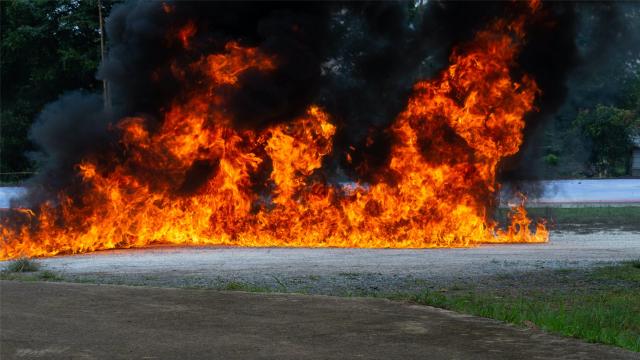Desperate times call for desperate measures, but if there is a shortage of petrol in your area, that is not a good reason to fill water bottles or, god forbid, plastic bags with gas. Hoard petrol if you must, but hoard your petrol in proper gas cans.
If you’ve only ever interacted with petrol by pumping it into your car, you may think of it simply as some kind of magic juice that makes vehicles move. But it has other physical and chemical properties, too. You probably know it’s astoundingly flammable. Also, it melts plastic.
Why doesn’t it melt approved, purpose-built plastic gas containers? Because not all plastics are alike. In fact, here’s a chart indicating the plastics that will stand up to petrol. Now, I’m not linking this to say “hey, go slosh gas into some buckets made of one of these hardier plastics and then store it irresponsibly,” but rather to illustrate that even if you saw somebody put petrol in a plastic container once and it didn’t dissolve before your eyes, that doesn’t mean that all plastic containers are safe.
Approved gas cans have more going for them, too. They have a pouring spot so you won’t get petrol everywhere when you try to actually put it in your tank (good luck filling your tank, plastic-bag-at-the-gas-station lady). Occupational Safety and Health Administration approved fuel containers, for example, include a “flash arresting screen, spring closing lid and spout cover and so designed that it will safely relieve internal pressure when subjected to fire exposure.” EPA-approved cans don’t have the same fireproof features, but they do close and vent automatically, and they are childproof.
Approved cans are also colour-coded: red for gasoline, yellow for diesel, blue for kerosene, green for other combustibles. These liquids all have different physical and chemical properties, so you really do not want to mix them up.
What’s the deal with venting and pressure? Well, petrol is a liquid that really wants to be in gas form instead. It will evaporate over time, and its fumes are especially flammable. If you’ve ever paid attention to an action movie with a car chase scene, you will recall that petrol explodes.
This also means that you really don’t want to store a large quantity of petrol, whether in a bunch of bags in the trunk of your car or in a giant tank strapped to a trailer. Check your local regulations: in many areas, you can’t have more than 30L of petrol in your house or on you property without a special permit. (And, yes, it’s best to keep it in a place like a shed or garage that is not connected to your house.)
Petrol vaporizes more quickly in hot temperatures, so you’ll want to keep it cool. And please don’t drive around with an enormous quantity of gas in your car’s trunk or backseat; the built-in petrol tank is already enough of a hazard that your car’s designers worked hard to keep it from killing you in the event of an accident.
You can read more safety tips here, like: don’t smoke around petrol, keep containers tightly closed, clean up spills promptly, and so on. And please, please, we beg you, never store petrol in a plastic bag.

Leave a Reply
You must be logged in to post a comment.